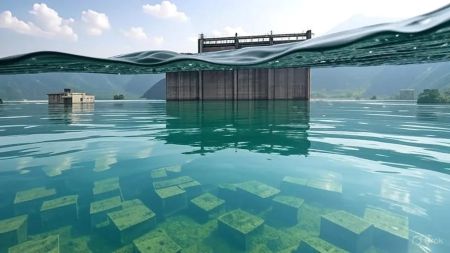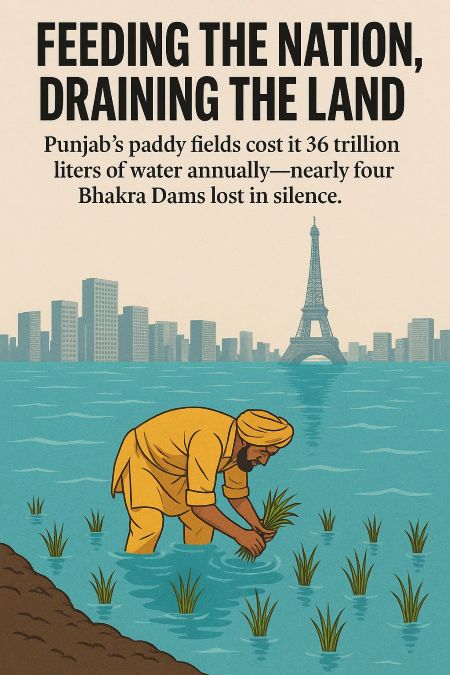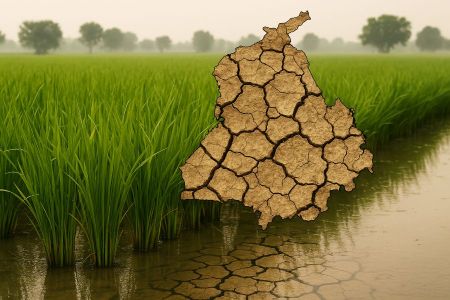A Crisis Beneath the Surface: Punjab’s Water Vanishes with Every Harvest
ON THE MORNING of June 1, at 10:21 AM, Punjab officially kicked off its paddy transplantation season—a seasonal ritual that reaffirms the state’s reputation as India’s rice bowl. But buried beneath this agricultural triumph lies an invisible catastrophe: Punjab is virtually exporting 36 trillion liters of water every year through its rice crop.
This isn’t just an environmental red flag—it’s a full-blown emergency masquerading as success under the so-called “Green Revolution.”
The Scale of the Silent Exodus
Punjab produces around 180 lakh tonnes of rice annually. Each kilogram of rice consumes between 2,000 to 3,000 litres of water. That means:
18,000,000,000 kg × 3,000 litres/kg = 54,000,000,000,000 liters
 Taking a conservative estimate of 36 trillion litres (@ 2,000 litres per kg), this is water “virtually exported” from Punjab, according to global studies on virtual water trade—embedded in agricultural commodities and shipped out to other states and countries, leaving Punjab’s aquifers emptier with each passing season.
Taking a conservative estimate of 36 trillion litres (@ 2,000 litres per kg), this is water “virtually exported” from Punjab, according to global studies on virtual water trade—embedded in agricultural commodities and shipped out to other states and countries, leaving Punjab’s aquifers emptier with each passing season.
Four Bhakra Dams, Gone Every Year
To comprehend the scale, consider the Bhakra Dam, one of India’s largest, with a full capacity of 9.34 billion cubic meters—that’s 9.34 trillion litres.
Punjab’s virtual water export equals:
36 ÷ 9.34 ≈ 3.85
That’s nearly four Bhakra Dams drained every year—not for Punjab’s needs, but to sustain a national procurement system that forces the state to grow what it cannot sustain.
Submerging Chandigarh: A Visual Metaphor
Chandigarh, Punjab’s shared capital, covers 114 square kilometres. If the 36 trillion litres were poured over it, the city would drown under:
36,000,000,000 m³ ÷ 114,000,000 m² ≈ 315.8 metres
 That’s enough water to:
That’s enough water to:
Submerge the Qutub Minar (73m) more than four times
Reach just 8 meters short of the Eiffel Tower (324m)
Climb 38% up the Burj Khalifa (828m)
This isn’t apocalyptic fantasy—it’s the hidden cost of our food security model.
A Global Outlier in Water Stress
Punjab’s water use is extreme even by global standards.
In 2015, the United States used 162 trillion litres annually for agricultural irrigation. Punjab alone uses over a fifth of that—despite being smaller than many U.S. counties.
California’s agriculture uses 41.9 trillion litres annually. Punjab, with a fraction of California’s landmass and GDP, uses nearly as much. This is not agricultural efficiency—it’s systemic failure.
A Crisis Beneath the Surface
Punjab’s water table is collapsing.
 A 2019 Nature Geoscience study revealed that the Indo-Gangetic plains are losing 19.2 gigatons of groundwater annually. According to The Tribune (May 31, 2025), each of Punjab’s 14 lakh tubewells draws over 30 lakh litres per week, powered by free electricity. With power demand now exceeding 17,000 MW, Punjab is bleeding both water and energy.
A 2019 Nature Geoscience study revealed that the Indo-Gangetic plains are losing 19.2 gigatons of groundwater annually. According to The Tribune (May 31, 2025), each of Punjab’s 14 lakh tubewells draws over 30 lakh litres per week, powered by free electricity. With power demand now exceeding 17,000 MW, Punjab is bleeding both water and energy.
Aquifers take centuries to replenish. Once gone, they don’t come back.
What Must Change
Experts at the Borlaug Institute for South Asia (BISA) recommend reducing paddy cultivation by 50%, replacing it with water-efficient crops like maize. This shift could cut water use by 30% and still protect farmer incomes—if supported by guaranteed procurement, assured MSP, and crop diversification incentives.
Also Read: How Clean is the River ‘Ganges’ or ‘Ganga’?
California’s SGMA (Sustainable Groundwater Management Act) targets a 20% reduction in agricultural water use by 2040 using both regulation and incentives.
Punjab must not just follow—it must lead. Because it has no choice.
Punjab Feeds the Nation.

But who will quench Punjab’s thirst?
The fields are green, but the future is drying out. And if Punjab’s thirst goes unanswered, it won’t just be a regional tragedy—it will be a national reckoning. If Punjab is to survive, policy must catch up with science, and emotion must give way to reason. The rice bowl of India cannot become its groundwater grave. ![]()
All calculations are based on publicly available data and may carry a minor margin of error.
________
Also Read:
Punjab’s Border Gambit: National Security or Constitutional Subversion?
Disclaimer : PunjabTodayNews.com and other platforms of the Punjab Today group strive to include views and opinions from across the entire spectrum, but by no means do we agree with everything we publish. Our efforts and editorial choices consistently underscore our authors’ right to the freedom of speech. However, it should be clear to all readers that individual authors are responsible for the information, ideas or opinions in their articles, and very often, these do not reflect the views of PunjabTodayNews.com or other platforms of the group. Punjab Today does not assume any responsibility or liability for the views of authors whose work appears here.
Punjab Today believes in serious, engaging, narrative journalism at a time when mainstream media houses seem to have given up on long-form writing and news television has blurred or altogether erased the lines between news and slapstick entertainment. We at Punjab Today believe that readers such as yourself appreciate cerebral journalism, and would like you to hold us against the best international industry standards. Brickbats are welcome even more than bouquets, though an occasional pat on the back is always encouraging. Good journalism can be a lifeline in these uncertain times worldwide. You can support us in myriad ways. To begin with, by spreading word about us and forwarding this reportage. Stay engaged.
— Team PT

